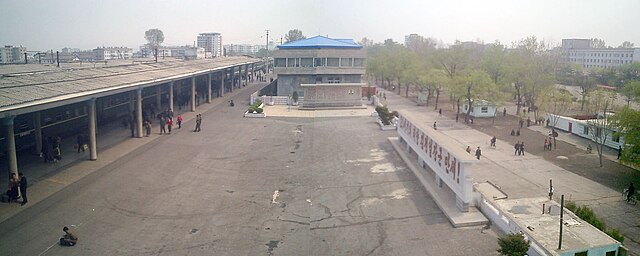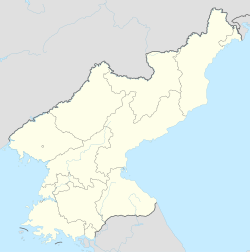Sinuiju
Municipal city in North P'yŏngan, North Korea From Wikipedia, the free encyclopedia
Sinŭiju (Korean: 신의주시; MR: Sinŭiju-si; IPA: [ɕinɰidzu ɕi]) is a city in North Korea which faces Dandong, Liaoning, China, across the international border of the Yalu River. It is the capital of North P'yŏngan province. Part of the city is included in the Sinŭiju Special Administrative Region, which was established in 2002 to experiment with introducing a market economy. In recent years, the city, despite lagging behind the development in the capital Pyongyang, has seen a small construction boom[contradictory] and increasing tourism from China.[2]
Sinŭiju
신의주시 | |
|---|---|
| transcription(s) | |
| • Chosŏn'gŭl | 신의주시 |
| • Hancha | 新義州市 |
| • Revised Romanization | Sinuiju-si |
| • McCune-Reischauer | Sinŭiju-si |
Clockwise from top: Aerial view of Downtown Sinŭiju, from Dandong, Apartment buildings, Sino-Korean Friendship Bridge, Sinuiju Chongnyon station | |
| Motto: The emblem Magnolia. | |
 Sinŭiju location within North Pyongan Province | |
 | |
| Coordinates: 40°06′N 124°24′E | |
| Country | North Korea |
| Province | North P'yŏngan |
| Administrative divisions | 49 tong, 9 ri |
| Area | |
• Total | 180 km2 (70 sq mi) |
| Population (2008) | |
• Total | 359,341[1] |
| • Dialect | P'yŏngan |
| Time zone | UTC+9 (Pyongyang Time) |
Geography



Sinŭiju is bordered by the Amnok River, and by P'ihyŏn and Ryongch'ŏn counties. The city's altitude is 1 metre (4 feet) above sea level. There are several islands at the mouth of the Amnok River - Wihwa-do, Rim-do, Ryuch'o-do and Tongryuch'o-do.
Administrative divisions
Summarize
Perspective
Sinuiju city is the heart of the Sinuiju Special Administrative Region. The city is currently divided into 49 tong (neighbourhoods) and 9 ri (villages):
| Name | Chosŏn'gŭl | Hanja |
|---|---|---|
| May 1st-dong (O-il-dong) | 5-1동 (오일동) | 五一洞 |
| Apkang-dong | 압강동 | 鴨江洞 |
| Chaeha-dong | 채하동 | 彩霞洞 |
| Chinseon 1-dong | 친선1동 | 親善一洞 |
| Chinseon 2-dong | 친선2동 | 親善二洞 |
| Cheongsong-dong | 청송동 | 靑松洞 |
| Haebang-dong | 해방동 | 解放洞 |
| Kaehyeok-dong | 개혁동 | 改革洞 |
| Koseong-dong | 고성동 | 古城洞 |
| Keunhwa-dong | 근화동 | 芹花洞 |
| Majeon-dong | 마전동 | 麻田洞 |
| Minpho-dong | 민포동 | 敏浦洞 |
| Namha-dong | 남하동 | 南下洞 |
| Namjung-dong | 남중동 | 南中洞 |
| Nammin-dong | 남민동 | 南敏洞 |
| Namsang-dong | 남상동 | 南上洞 |
| Namseo-dong | 남서동 | 南西洞 |
| Namsong-dong | 남송동 | 南松洞 |
| Baekun-dong | 백운동 | 白雲洞 |
| Baeksa-dong | 백사동 | 白沙洞 |
| Baekto-dong | 백토동 | 白土洞 |
| Bangjik-tong | 방직동 | 紡織洞 |
| Bonbu-dong | 본부동 | 本部洞 |
| Panmun-dong | 판문동 | 板門洞 |
| Pungseo 1-dong | 풍서1동 | 豊西一洞 |
| Pungseo 2-dong | 풍서2동 | 豊西二洞 |
| Pyeonghwa-dong | 평화동 | 平和洞 |
| Ragwon 1-dong | 락원1동 | 樂園一洞 |
| Ragwon 2-dong | 락원2동 | 樂園二洞 |
| Rakcheong 1-dong | 락청1동 | 樂清一洞 |
| Rakcheong 2-dong | 락청2동 | 樂清二洞 |
| Ryeonsang 1-dong | 련상1동 | 蓮上一洞 |
| Ryeonsang 2-dong | 련상2동 | 蓮上二洞 |
| Ryusang 1-dong | 류상1동 | 柳上一洞 |
| Ryusang 2-dong | 류상2동 | 柳上二洞 |
| Sinnam-dong | 신남동 | 新南洞 |
| Sinpo-dong | 신포동 | 新浦洞 |
| Sinwon-dong | 신원동 | 新元洞 |
| Seokha 1-dong | 석하1동 | 石下一洞 |
| Seokha 2-dong | 석하2동 | 石下二洞 |
| Songhan-dong | 송한동 | 送鷴洞 |
| Seonsang-dong | 선상동 | 仙上洞 |
| Sumun-dong | 수문동 | 水門洞 |
| Dongha-dong | 동하동 | 東下洞 |
| Dongjung-dong | 동중동 | 東中洞 |
| Dongsang-dong | 동상동 | 東上洞 |
| Wai-dong | 와이동 | 瓦耳洞 |
| Yeokcheon-dong | 역전동 | 驛前洞 |
| Yeonha-dong | 연하동 | 煙下洞 |
| Jungjae-ri | 중재리 | 中斉里 |
| Hadan-ri | 하단리 | 下端里 |
| Ryucho-ri | 류초리 | 柳草里 |
| Samgyo-ri | 삼교리 | 三橋里 |
| Samryong-ri | 삼룡리 | 三龍里 |
| Sangdan-ri | 상단리 | 上端里 |
| Seongseo-ri | 성서리 | 城西里 |
| Daji-ri | 다지리 | 多智里 |
| Toseong-ri | 토성리 | 土城里 |
History
Summarize
Perspective
Developed as a major settlement during the colonial rule at the terminus of a railway bridge across the Amrok River, Sinuiju is located 11 km (7 miles) south by southwest of Ŭiju, the old city from whose name Sinŭiju (meaning “New Ŭiju”) derives. As an open port, it grew commercially with the logging industry which uses the Amnok River to transport lumber. Additionally, a chemical industry developed after the hydroelectric Sup'ung Dam was built further up the river.
In the course of the Korean War, after being driven from P'yŏngyang, Kim Il Sung and his government temporarily moved its capital to Sinŭiju[3][4] - although as UNC forces approached, the government again moved - this time to Kanggye.[4] On the 7th of november 1950, the city sustained heavy damage during an aerial bombardment from the United States Air Force; 95 percent of the city was destroyed.[5] However, the city has since been rebuilt.
In 2018, a master plan for the redevelopment of the city was unveiled and shown to Kim Jong Un, which would have featured many high rise buildings and parks, centered around the road leading to the statues of Kim Il Sung and Kim Jong Il. Ultimately, this plan has yet to be fulfilled, with the only major work completed being the repaving of roads leading to the statues and the red coloured, circular apartment building behind and the Sinuiju Youth Open Air Theatre's completion, although the industrial areas in the city have seen some reconstruction.[6]
Economy

An important light industry centre in North Korea, Sinŭiju has a plant manufacturing enamelled ironware as well as a textile mill, paper mill and an afforestation factory. Its southwest harbour has a shipyard, although the shipyard's main function is seemingly to dismantle ships for scrap metal and other usable materials rather than building new ships. The area has recycling plants which recycle a wide range of material, including products that are banned for recycling in China.[7][8][9] The Sinŭiju Cosmetics Factory is located in South Sinŭiju (Namsinŭiju).
Trade with China
A substantial portion of North Korea's international trade, both legal and illegal, passes through Sinuiju and Dandong, across the Yalu River.[10]
Central market
Since 2002, commercial life has been centred on the Chaeha-dong Market.[11] Based on a satellite image taken on 30 October 2012, the market has been destroyed and is being made into a new park.[11]
Transportation
Summarize
Perspective

Sinŭiju can be reached from P'yŏngyang by air, railway and road. It can be reached from Dandong in China by crossing the Amnok River by bridge or boat. Foreign tourists on excursion boats from Dandong are sometimes permitted to approach within a few meters of the city's coastline, as long as they do not land.[12]
Air
Sinŭiju's airport has a single turf runway 03/21 measuring 991 metres by 61 metres (3250 feet by 213 feet).[13] Air Koryŏ operates passenger and cargo flights from P'yŏngyang.
Rail
Sinŭiju Ch'ŏngnyŏn Station is the northern terminus of the Korean State Railway's P'yŏngŭi Line from P'yŏngyang; the district is also served by several other stations on the P'yŏngŭi line, as well as the Tŏkhyŏn and Paengma lines. It is also connected with the Chinese city of Dandong in Liaoning Province (China) by the Sino-Korean Friendship Bridge, which is 944 m (3,097 ft) long from end to end, and through the Manchuria Railway links up with the Trans-Siberian railway. The factories of the city of Sinŭiju are provided with railway service via the Kang'an Line.
Urban transit
Sinuiju has a trolleybus line that runs from the city centre to the railway station. It was reopened in October 2020 with new trolleybuses derived from the Pyongyang Chollima-321 trolleybus. It formerly had another line running from the Sinuiju Chongnyon Station to Ragwon Machine Complex that closed between 2005 and 2009 with the reconstruction of the highway with a shifted alignment.[14]
Climate
Summarize
Perspective
Sinŭiju has a monsoonal humid continental climate (Köppen Dwa) with hot, humid and stormy summers and cold, dry winters with little snowfall.
| Climate data for Sinuiju (1991–2020 normals, extremes 1957–present) | |||||||||||||
|---|---|---|---|---|---|---|---|---|---|---|---|---|---|
| Month | Jan | Feb | Mar | Apr | May | Jun | Jul | Aug | Sep | Oct | Nov | Dec | Year |
| Record high °C (°F) | 9.2 (48.6) |
15.5 (59.9) |
22.0 (71.6) |
28.4 (83.1) |
32.0 (89.6) |
37.0 (98.6) |
36.9 (98.4) |
38.5 (101.3) |
33.0 (91.4) |
28.9 (84.0) |
23.1 (73.6) |
13.9 (57.0) |
38.5 (101.3) |
| Mean daily maximum °C (°F) | −0.8 (30.6) |
2.9 (37.2) |
8.8 (47.8) |
16.1 (61.0) |
22.0 (71.6) |
25.9 (78.6) |
28.3 (82.9) |
29.2 (84.6) |
25.6 (78.1) |
18.3 (64.9) |
8.7 (47.7) |
0.5 (32.9) |
15.5 (59.9) |
| Daily mean °C (°F) | −6.2 (20.8) |
−2.8 (27.0) |
3.2 (37.8) |
10.1 (50.2) |
16.2 (61.2) |
20.9 (69.6) |
24.1 (75.4) |
24.5 (76.1) |
19.7 (67.5) |
12.2 (54.0) |
3.6 (38.5) |
−4.2 (24.4) |
10.1 (50.2) |
| Mean daily minimum °C (°F) | −10.3 (13.5) |
−7.2 (19.0) |
−1.2 (29.8) |
5.4 (41.7) |
11.5 (52.7) |
17.0 (62.6) |
21.2 (70.2) |
21.1 (70.0) |
15.1 (59.2) |
7.5 (45.5) |
−0.4 (31.3) |
−8.0 (17.6) |
6.0 (42.8) |
| Record low °C (°F) | −27.3 (−17.1) |
−26.0 (−14.8) |
−18.9 (−2.0) |
−5.0 (23.0) |
−2.6 (27.3) |
3.0 (37.4) |
10.7 (51.3) |
10.0 (50.0) |
2.8 (37.0) |
−5.3 (22.5) |
−15.0 (5.0) |
−22.8 (−9.0) |
−27.3 (−17.1) |
| Average precipitation mm (inches) | 5.9 (0.23) |
14.9 (0.59) |
20.3 (0.80) |
53.7 (2.11) |
85.0 (3.35) |
122.6 (4.83) |
251.9 (9.92) |
241.3 (9.50) |
95.7 (3.77) |
78.8 (3.10) |
37.2 (1.46) |
13.6 (0.54) |
1,020.9 (40.19) |
| Average precipitation days (≥ 0.1 mm) | 2.1 | 3.2 | 3.8 | 6.4 | 7.7 | 9.8 | 12.6 | 10.4 | 5.7 | 5.6 | 5.2 | 4.0 | 76.5 |
| Average snowy days | 3.5 | 3.1 | 2.1 | 0.3 | 0.1 | 0.0 | 0.0 | 0.0 | 0.0 | 0.1 | 1.9 | 4.4 | 15.5 |
| Average relative humidity (%) | 60.2 | 59.9 | 61.8 | 63.7 | 70.0 | 78.0 | 84.2 | 81.7 | 73.7 | 68.0 | 65.6 | 62.5 | 69.1 |
| Mean monthly sunshine hours | 199 | 195 | 227 | 228 | 237 | 207 | 163 | 200 | 220 | 208 | 169 | 172 | 2,425 |
| Source 1: Korea Meteorological Administration[15] | |||||||||||||
| Source 2: Deutscher Wetterdienst (sun, 1961–1990),[16][17][a] Meteo Climat (extremes),[18] Extreme Temperature Around The World [19] | |||||||||||||
Places of interest

Facilities in Sinŭiju include Sinŭiju High School, Sinŭiju Commercial High School, Eastern Middle School, Sinŭiju Light Industry University, Sinŭiju University of Medicine and the Sinuiju University of Education. Scenic sites include the Tonggun Pavilion, Waterfall, and Hot Springs.
There also is a Ferris wheel overlooking the Yalu River, reportedly broken.[20]
Notable people
- Sohn Kee-chung, South Korean Olympic athlete and long-distance runner
- Yi Sung-sun, South Korean street knight
- Yushoku Cho, Japanese speed skater
See also
Notes
- Station ID for Sinuiju is 47035 Use this station ID to locate the sunshine duration
References
Further reading
External links
Wikiwand - on
Seamless Wikipedia browsing. On steroids.





